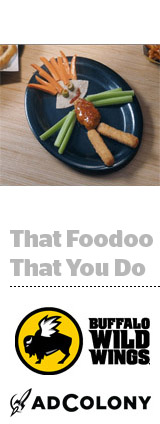
Buffalo Wild Wings is leveraging interactive mobile video to extend its TV advertising efforts – and give consumers a chance to play with their food.
The casual dining and sports bar chain worked with mobile video ad company AdColony to develop a game-like video ad experience featuring “Foodoo,” a voodoo doll with carrots for its spiky orange hair, olives for eyes, a chicken wing as the torso, celery sticks for arms and mozzarella sticks for its legs.
During March Madness, Buffalo Wild Wings featured Foodoo in a television campaign in which friends watching a college basketball game at a B-Dubs restaurant seem to unintentionally cause onscreen damage to a player at the free-throw line when they take bites from Foodoo’s limbs.
Buffalo Wild Wings riffed on the TV spot by tapping into Aurora HD Video, an interactive ad unit from AdColony that lets people engage with the content they’re watching.
In the mobile video ad, which ran between late June and late July, users had to catch Foodoo by tapping on the screen as the doll popped in and out of view while the TV ad played in the background. Every tap left behind a little smear of digital chicken wing sauce and caused a haptic vibration that knocked off Foodoo’s body parts.
Upon catching Foodoo, players were given the option to join the Buffalo Wild Wing loyalty program or click to find a nearby restaurant location. They could also rebuild Foodoo’s body on a platter to earn loyalty points.
“The unit acted as an extension of our current messaging strategy,” said Bob Ruhland, VP of marketing for North America at Buffalo Wild Wings.
The combination of branding and calls to action also fit in with the KPIs the brand wanted to achieve, he said.
Beyond creating a deeper, more engaging connection with customers by leveraging existing assets, the brand has an eye on driving specific real-world actions, Ruhland said.
That deeper level of engagement is possible because consumers are able to play the game within the actual ad unit.
“Rather than a button overlay that takes you out of the video, which is the case with a lot of ‘interactive’ video, this unit allows you to touch, tap, tilt or swirl – everything you do affects what happens on the screen,” said AdColony CEO Will Kassoy. “This is actually using the phone’s unique hardware to make the experience even more interactive.”
 Buffalo Wild Wings targeted the ad using a multiple parameters, including context, past app usage and location to reach consumers with an affinity for sports and B-Dubs.
Buffalo Wild Wings targeted the ad using a multiple parameters, including context, past app usage and location to reach consumers with an affinity for sports and B-Dubs.
“We wanted to leverage a variety of different targeting techniques to reach consumers that were not only relevant, but also demonstrated attributes that would allow Buffalo Wild Wings to directly engage with them and make a genuine connection,” said Kaitlyn McInnes, digital media director at Horizon Media, where she leads digital strategy and activation for Buffalo Wild Wings.
The results were tasty. The interactive Foodoo campaign generated nearly 46 million interactions overall, a 93.4% video completion rate and a 37% unique interaction rate, meaning unduplicated engagements with the unit. The viewability rate was 90%.
“It’s hard to get consumer attention today,” Kassoy said. “But the engagement we’re seeing here is a good indication that the message was getting through and people were paying attention.”
That said, this type of unit needs to be used judiciously. You can’t launch an interactive haptic video experience every day or consumers will start to disengage.
“This framework gives marketers a palette of tools that lets them be creative and make an impact,” Kassoy said. “But it shouldn’t be overused or done in silly ways that are annoying or distracting.”
This post was syndicated from Ad Exchanger.

More Stories
Kiwi media agency D3 appoints Lani Jamieson as General Manager
Sinclair Broadens Use of Artificial Intelligence to Make Local News More Accessible
Making the invisible visible: Women’s Work exhibition to amplify female voices